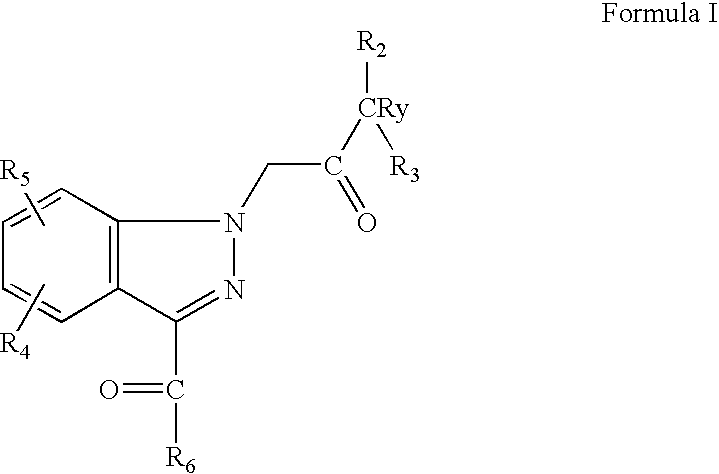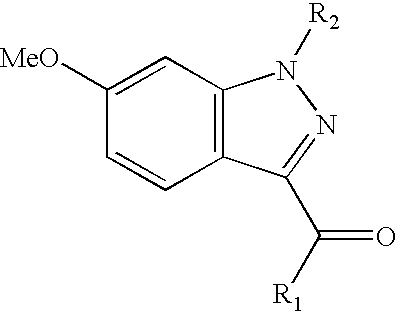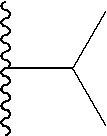Ophthalmic compositions for treating ocular hypertension
a technology of ocular hypertension and compositions, applied in the field of ophthalmic compositions for treating ocular hypertension, can solve the problems of unsatisfactory side effects, unsatisfactory efficacy and unsatisfactory side effects of these agents, and irreversible loss of visual function
- Summary
- Abstract
- Description
- Claims
- Application Information
AI Technical Summary
Benefits of technology
Problems solved by technology
Method used
Image
Examples
example 6
PREPARATIVE EXAMPLE 6
[0073]
[0074] The desired compound was prepared by a procedure similar to the one described for Preparative Example 5, but cyclohexyl magnesium bromide was used in place of cyclopentyl magnesium bromide. 1H NMR (CDCl3) δ: 1.327 (1H, m), 1.479 (2H, m), 1.604 (2H, m), 1.781 (1H, m), 1.861 (2H, m), 2.000 (2H, m), 3.641 (1H, m), 3.902 (3H, s), 6.923 (1H, s), 7.008 (1H, d), 8.259 (1H, d).
example 1
[0075]
[0076] Indazole (0.60 mmoles from Preparative Example 3) starting material obtained as above was dissolved in DMF (3 mL) followed by the addition of sodium hydride (0.88 mmoles). The reaction was stirred at room temperature for 15 min, followed by the addition of tert-butyl bromo acetate (0.669 mmoles). The reaction was stirred at room temperature for 30 min. TLC and LC-MS analysis indicated complete consumption of starting material concurrent with the formation of a new product spot. The reaction mixture was quenched by the addition of water. Standard aqueous work-up followed by purification of crude by SGC gave the desired product as white solid.
[0077] 1H NMR in CDCL: 8.22 (1H, d, J=9 Hz); 6.97 (1H, dd, J=2 and 9 Hz); 6.5 (1H, d J=2 Hz); 5.4 (2H, s); 3.94 (3H, s); 2.8 (1H, m); 1.38 (9H, s); 1.27 (6H, d, J=6.5 Hz).
[0078] LCMS=[M+H]=317
example 2
[0079]
[0080] 1-(3-{[6-(2 hydroxyethyl)pyridine-3-yl]carbonyl}-6-methoxy-1H-indazol-1-yl)-3,3-dimethylbutan-2-one
Step A:
[0081] To a solution of 2,5-dibromopyridine (2.4 g) in toluene was added tributylallyltin (3.4 ml) and dichlorobis(triphenylphosphine) palladium (0.7 g) under nitrogen atmosphere. The mixture was refluxed for a couple of hours and concentrated under reduced pressure. The residue was re-dissolved in “wet ether” and added DBU (3 ml) slowly to give a cloudy solution. The mixture was filtered over a pad of silica gel and concentrated. The residue was dissolved in methylene chloride / methanol=1 / 1 solution and cooled to −78° C. To this solution was bubbled though ozone until the reaction mixture became a blue color. The reaction was warmed to 0° C. and added sodium borohydride (0.5 g) portion-wise. After stirring at 0° C. for 1 hour, the mixture was poured into water and extracted with ethyl acetate. The organic layer was washed with 1N NaOHaq, brine, dried (MgSO4), an...
PUM
| Property | Measurement | Unit |
|---|---|---|
| temperature | aaaaa | aaaaa |
| temperature | aaaaa | aaaaa |
| temperature | aaaaa | aaaaa |
Abstract
Description
Claims
Application Information
 Login to View More
Login to View More - R&D
- Intellectual Property
- Life Sciences
- Materials
- Tech Scout
- Unparalleled Data Quality
- Higher Quality Content
- 60% Fewer Hallucinations
Browse by: Latest US Patents, China's latest patents, Technical Efficacy Thesaurus, Application Domain, Technology Topic, Popular Technical Reports.
© 2025 PatSnap. All rights reserved.Legal|Privacy policy|Modern Slavery Act Transparency Statement|Sitemap|About US| Contact US: help@patsnap.com



